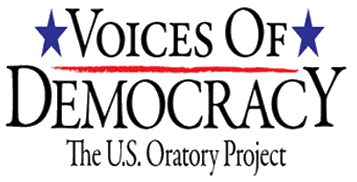FANNIE LOU HAMER, “WE’RE ON OUR WAY” (SEPTEMBER 1964)
Classroom Activities
- Ethos, or the creation of a speaker’s goodwill and credibility during a speech, is a critical component of speechmaking. How does Fannie Lou Hamer craft her ethos before her Indianola listeners?
- People who had the opportunity to hear Fannie Lou Hamer speak say that her delivery was extremely powerful. Listening to the address, what stands out as remarkable about her delivery? What evidence is there from the recording that indicates how her speech was received?
- What would have happened to this speech if Moses Moon had not recorded it? How would that change our understanding of Fannie Lou Hamer and her role in the Mississippi civil rights movement?
- Working individually or in a small group, transcribe several paragraphs of Hamer’s speech. Compare that transcription with your classmates’ transcription. What choices did you make in rendering her spoken English into written English? How might those choices affect how we see and understand Hamer? Compare your transcriptions with the version of the speech found in the collection edited by Parker Brooks and Houck and the version included in the Houck and Dixon anthology.
- One group of villains in Hamer’s speech is black preachers. Why, given her own extended appeals to the Judeo-Christian tradition, does she hold them in such contempt? How does she balance her criticism of them with the preacher-like persona she adopts?
- Outline the speech. Does it follow a logical organizational structure? What might the rhetorical purpose of Hamer’s organizational structure be? How might you structure the address differently?
Student Research
- Go to the Mississippi Sovereignty Commission papers in the Digital Archives of the Mississippi Department of Archives and History (http://mdah.state.ms.us/arrec/digital_archives/sovcom/). Using search terms such as “Winona,” “Earle W. Patridge,” “John L. Basinger” or “Thomas J. Herod,” document how law enforcement officials in Montgomery County violated the laws of the federal government. How did officials treat blacks who sought to integrate Staley’s Café?
- Using the same digital archives of the Mississippi Sovereignty Commission, document how, where, and why white elected officials in the state spied on Fannie Lou Hamer.
- Using the anthropological work of John Dollard, Caste and Class in a Southern Town, and Hortense Powdermaker, After Freedom: A Cultural Study in the Deep South, explain the religious beliefs of black residents of Indianola. What do these beliefs tell us about Fannie Lou Hamer’s religious appeals in her speech?
- Using U.S. Census data from 1950, 1960, 1970, and 2010, document the extent of black voter registration in the counties of Leflore, Sunflower, Issaquena, Tallahatchie, Washington, Holmes and Humphreys.
- Many scholars and activists have argued that black women were “overrepresented” in the Mississippi civil rights movement; that is, black women far outnumbered black men when it came to public freedom work. Generate a list of possible reasons why, using Houck and Dixon’s introduction to Women and the Civil Rights Movement, 1954-65. See if your reasons are confirmed.
- Compare and contrast Fannie Lou Hamer’s 1964 speech in Indianola with her December 1964 speech with Malcolm X in Harlem, New York (found in the Parker Brooks and Houck collection). What are the core differences between these audiences and how do those differences affect the substance of her message?
Citizenship Resources
- In 2006, then President George W. Bush signed the Voting Rights Reauthorization and Amendment Act. What is re-authorized from the original 1965 Voting Rights Act and what is amended?
- To be a registered voter in your county, municipality or state, what requirements have to be met?
- In many states, convicted felons cannot vote or must wait many months or even years after their sentence has been served before they can resume their voting privileges. Can felons/ex-felons vote in your state? If not, what must they do to have their rights restored? Which groups of people (race, class, and gender) are most affected by these felon laws?
- How have grassroots appeals to local communities changed in the digital age? While speaking at local churches and in black schoolhouses was an effective strategy for Hamer over forty years ago, what types of strategies do grassroots activists now have at their disposal to engage their local communities? How do these new media affect the activist message?
- Julian Bond, a friend of Hamer and fellow SNCC activist, who went on to serve in the Georgia House of Representatives and Chair the NAACP, contends that “gay rights are civil rights.” Watch the youtube clip of his keynote address at the 20th National Conference on LGBT Equality: http://www.youtube.com/watch?v=ASjzPJ1iV9g. Consider his justification for this contention. What is illuminating about comparing the African American civil rights movement of the 1950s and 1960s and the present LGBT fight for marriage equality? Why is this comparison controversial?
- Beyond the movement for LGBT citizenship rights, which other current movements for social justice in the United States could be compared to the African American civil rights movement of the 1950s and 1960s? What might these movements learn from the words of Fannie Lou Hamer?
Last updated May 4, 2016
